NSG2FNH: Cultural Safety Skills in First Nations Healthcare Delivery
VerifiedAdded on 2023/06/11
|5
|1220
|171
Report
AI Summary
This report discusses the importance of cultural safety in providing healthcare services to First Nations people. It highlights the power dynamics between nurses and patients and emphasizes the need for nursing staff to incorporate culturally safe practices in their service delivery. The report reflects on clinical scenarios where cultural safety is crucial, including using appropriate language, building trust, and understanding the unique health concepts of First Nations communities. It also addresses challenges like health inequalities and cultural perceptions, while emphasizing the importance of effective communication, data collection, and collaborative decision-making to improve healthcare outcomes for First Nations people. The report underscores the significance of creating a socially, spiritually, and emotionally safe environment and learning from First Nations cultures to provide person-centered care.
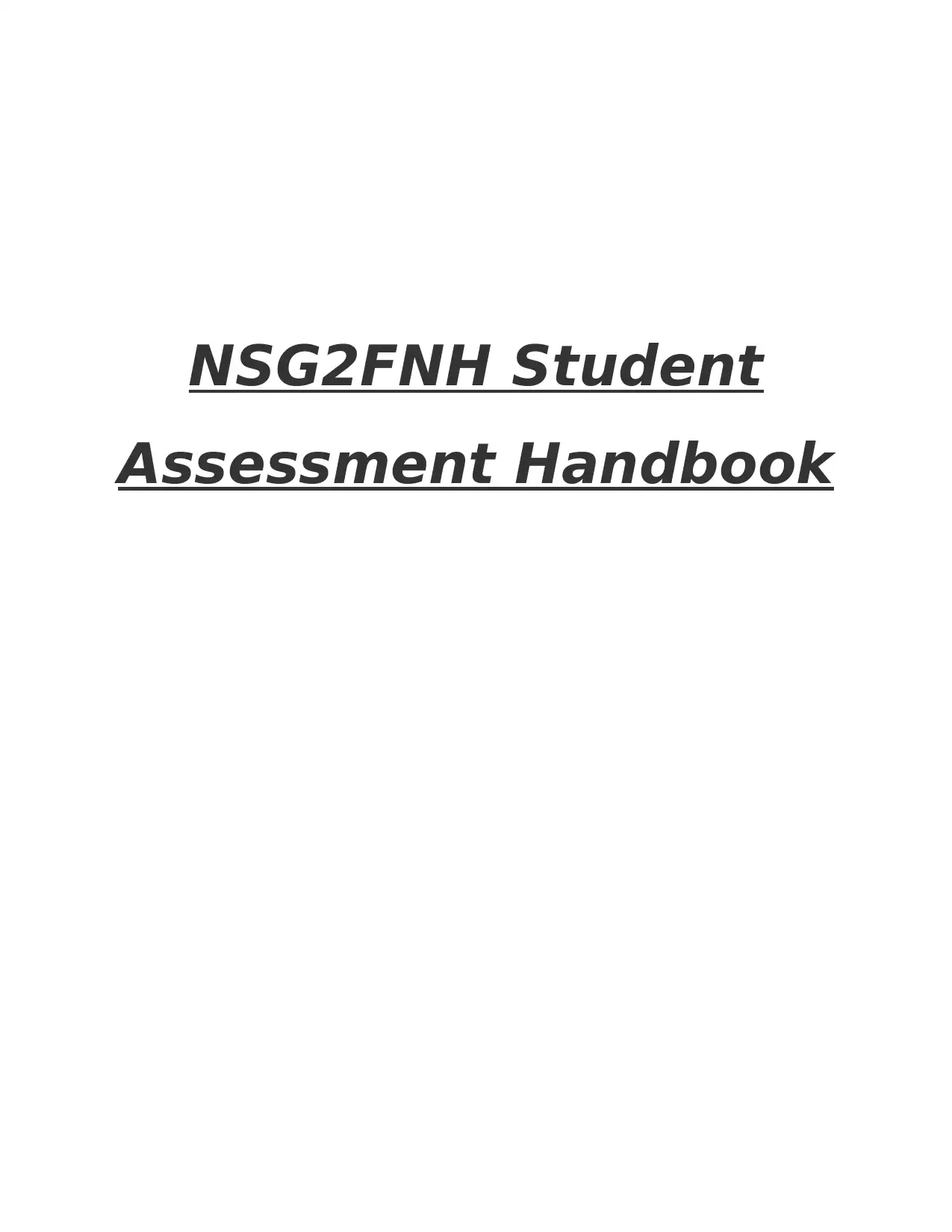
NSG2FNH Student
Assessment Handbook
Assessment Handbook
Paraphrase This Document
Need a fresh take? Get an instant paraphrase of this document with our AI Paraphraser
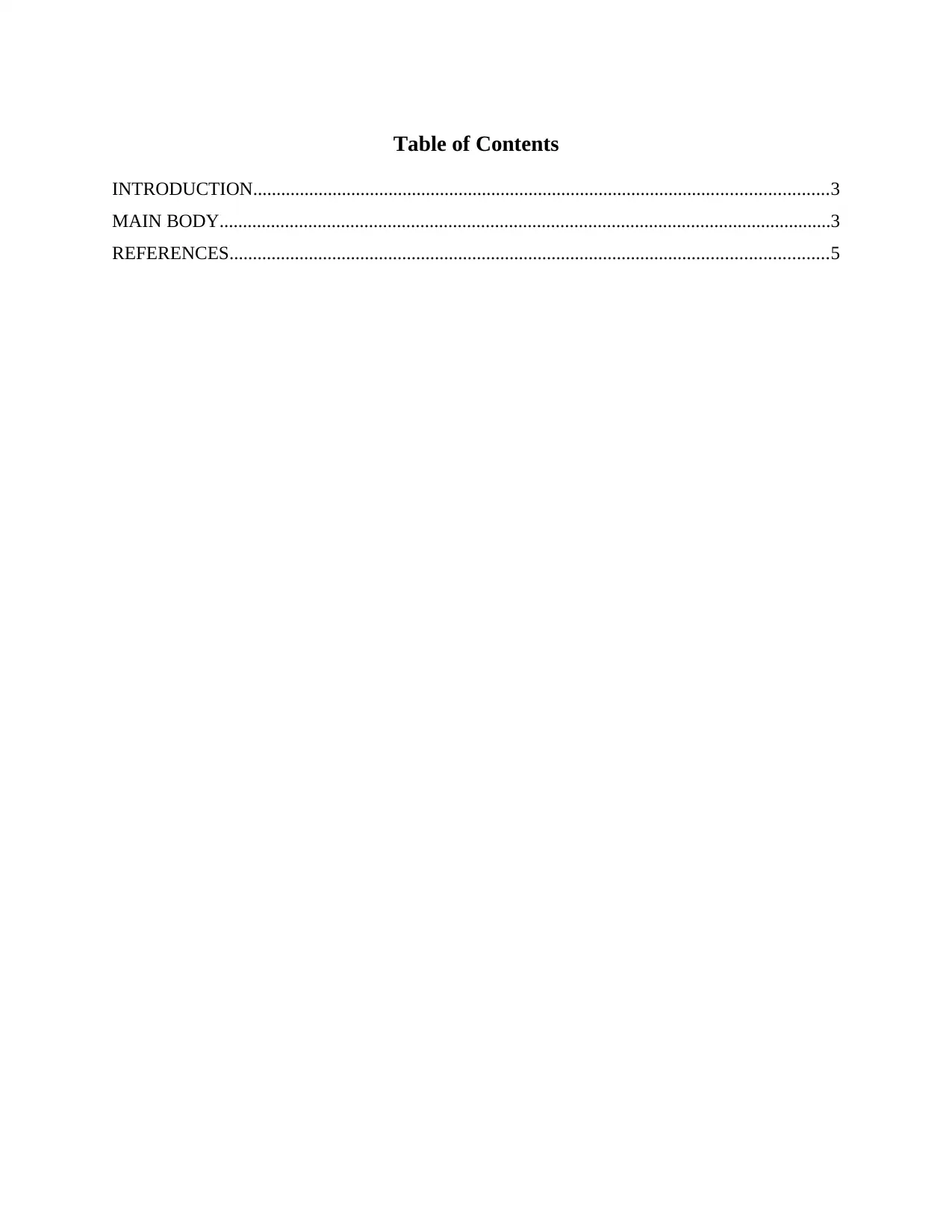
Table of Contents
INTRODUCTION...........................................................................................................................3
MAIN BODY...................................................................................................................................3
REFERENCES................................................................................................................................5
INTRODUCTION...........................................................................................................................3
MAIN BODY...................................................................................................................................3
REFERENCES................................................................................................................................5
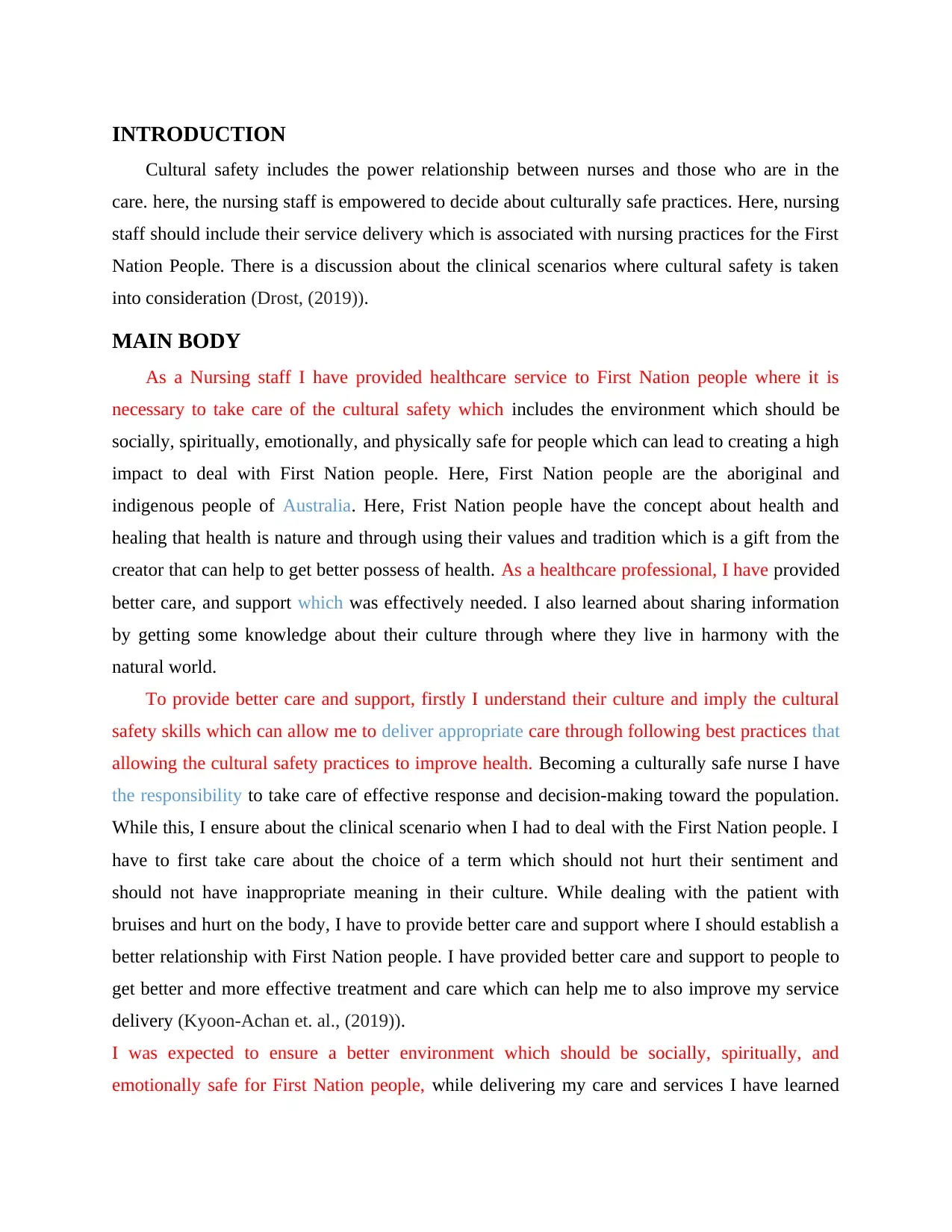
INTRODUCTION
Cultural safety includes the power relationship between nurses and those who are in the
care. here, the nursing staff is empowered to decide about culturally safe practices. Here, nursing
staff should include their service delivery which is associated with nursing practices for the First
Nation People. There is a discussion about the clinical scenarios where cultural safety is taken
into consideration (Drost, (2019)).
MAIN BODY
As a Nursing staff I have provided healthcare service to First Nation people where it is
necessary to take care of the cultural safety which includes the environment which should be
socially, spiritually, emotionally, and physically safe for people which can lead to creating a high
impact to deal with First Nation people. Here, First Nation people are the aboriginal and
indigenous people of Australia. Here, Frist Nation people have the concept about health and
healing that health is nature and through using their values and tradition which is a gift from the
creator that can help to get better possess of health. As a healthcare professional, I have provided
better care, and support which was effectively needed. I also learned about sharing information
by getting some knowledge about their culture through where they live in harmony with the
natural world.
To provide better care and support, firstly I understand their culture and imply the cultural
safety skills which can allow me to deliver appropriate care through following best practices that
allowing the cultural safety practices to improve health. Becoming a culturally safe nurse I have
the responsibility to take care of effective response and decision-making toward the population.
While this, I ensure about the clinical scenario when I had to deal with the First Nation people. I
have to first take care about the choice of a term which should not hurt their sentiment and
should not have inappropriate meaning in their culture. While dealing with the patient with
bruises and hurt on the body, I have to provide better care and support where I should establish a
better relationship with First Nation people. I have provided better care and support to people to
get better and more effective treatment and care which can help me to also improve my service
delivery (Kyoon-Achan et. al., (2019)).
I was expected to ensure a better environment which should be socially, spiritually, and
emotionally safe for First Nation people, while delivering my care and services I have learned
Cultural safety includes the power relationship between nurses and those who are in the
care. here, the nursing staff is empowered to decide about culturally safe practices. Here, nursing
staff should include their service delivery which is associated with nursing practices for the First
Nation People. There is a discussion about the clinical scenarios where cultural safety is taken
into consideration (Drost, (2019)).
MAIN BODY
As a Nursing staff I have provided healthcare service to First Nation people where it is
necessary to take care of the cultural safety which includes the environment which should be
socially, spiritually, emotionally, and physically safe for people which can lead to creating a high
impact to deal with First Nation people. Here, First Nation people are the aboriginal and
indigenous people of Australia. Here, Frist Nation people have the concept about health and
healing that health is nature and through using their values and tradition which is a gift from the
creator that can help to get better possess of health. As a healthcare professional, I have provided
better care, and support which was effectively needed. I also learned about sharing information
by getting some knowledge about their culture through where they live in harmony with the
natural world.
To provide better care and support, firstly I understand their culture and imply the cultural
safety skills which can allow me to deliver appropriate care through following best practices that
allowing the cultural safety practices to improve health. Becoming a culturally safe nurse I have
the responsibility to take care of effective response and decision-making toward the population.
While this, I ensure about the clinical scenario when I had to deal with the First Nation people. I
have to first take care about the choice of a term which should not hurt their sentiment and
should not have inappropriate meaning in their culture. While dealing with the patient with
bruises and hurt on the body, I have to provide better care and support where I should establish a
better relationship with First Nation people. I have provided better care and support to people to
get better and more effective treatment and care which can help me to also improve my service
delivery (Kyoon-Achan et. al., (2019)).
I was expected to ensure a better environment which should be socially, spiritually, and
emotionally safe for First Nation people, while delivering my care and services I have learned
⊘ This is a preview!⊘
Do you want full access?
Subscribe today to unlock all pages.

Trusted by 1+ million students worldwide
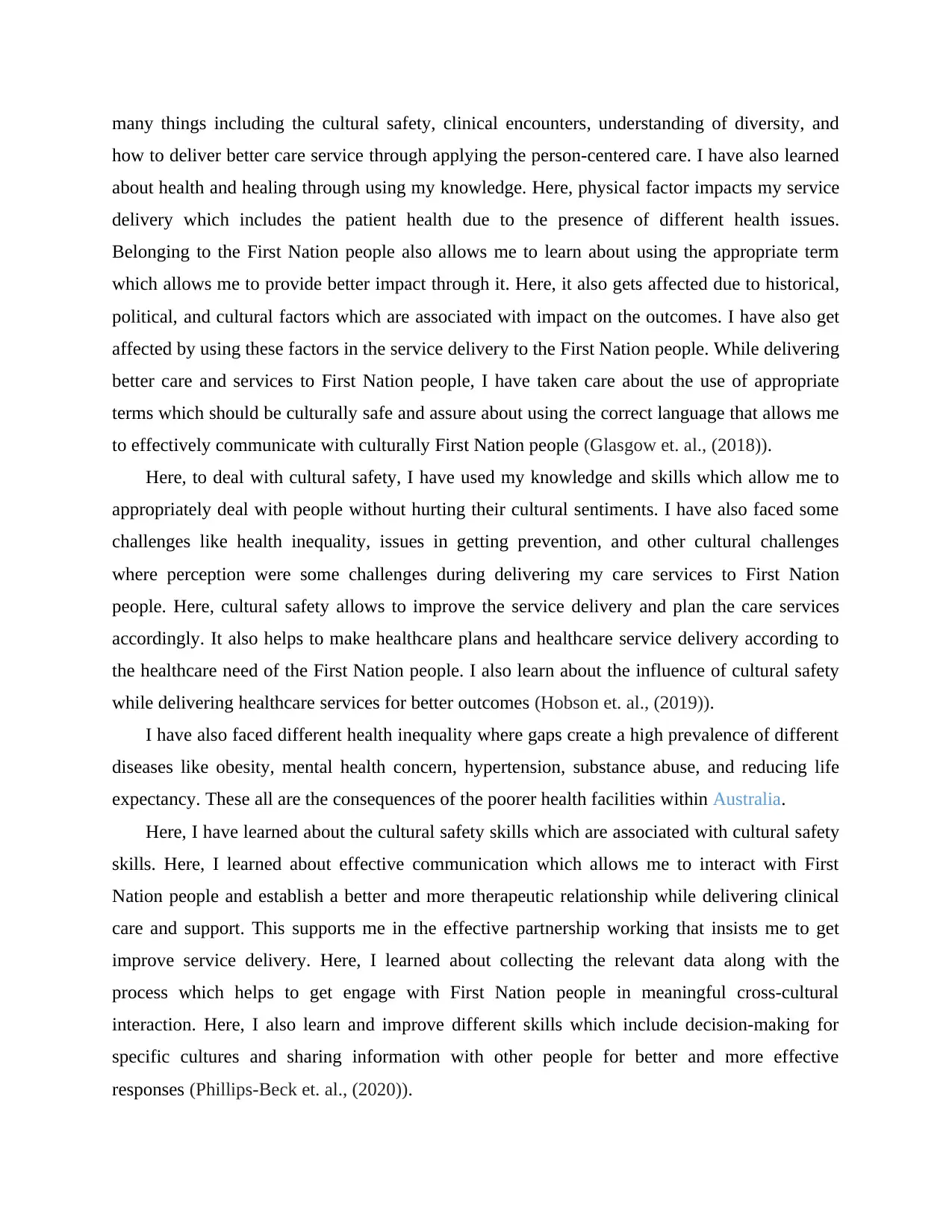
many things including the cultural safety, clinical encounters, understanding of diversity, and
how to deliver better care service through applying the person-centered care. I have also learned
about health and healing through using my knowledge. Here, physical factor impacts my service
delivery which includes the patient health due to the presence of different health issues.
Belonging to the First Nation people also allows me to learn about using the appropriate term
which allows me to provide better impact through it. Here, it also gets affected due to historical,
political, and cultural factors which are associated with impact on the outcomes. I have also get
affected by using these factors in the service delivery to the First Nation people. While delivering
better care and services to First Nation people, I have taken care about the use of appropriate
terms which should be culturally safe and assure about using the correct language that allows me
to effectively communicate with culturally First Nation people (Glasgow et. al., (2018)).
Here, to deal with cultural safety, I have used my knowledge and skills which allow me to
appropriately deal with people without hurting their cultural sentiments. I have also faced some
challenges like health inequality, issues in getting prevention, and other cultural challenges
where perception were some challenges during delivering my care services to First Nation
people. Here, cultural safety allows to improve the service delivery and plan the care services
accordingly. It also helps to make healthcare plans and healthcare service delivery according to
the healthcare need of the First Nation people. I also learn about the influence of cultural safety
while delivering healthcare services for better outcomes (Hobson et. al., (2019)).
I have also faced different health inequality where gaps create a high prevalence of different
diseases like obesity, mental health concern, hypertension, substance abuse, and reducing life
expectancy. These all are the consequences of the poorer health facilities within Australia.
Here, I have learned about the cultural safety skills which are associated with cultural safety
skills. Here, I learned about effective communication which allows me to interact with First
Nation people and establish a better and more therapeutic relationship while delivering clinical
care and support. This supports me in the effective partnership working that insists me to get
improve service delivery. Here, I learned about collecting the relevant data along with the
process which helps to get engage with First Nation people in meaningful cross-cultural
interaction. Here, I also learn and improve different skills which include decision-making for
specific cultures and sharing information with other people for better and more effective
responses (Phillips-Beck et. al., (2020)).
how to deliver better care service through applying the person-centered care. I have also learned
about health and healing through using my knowledge. Here, physical factor impacts my service
delivery which includes the patient health due to the presence of different health issues.
Belonging to the First Nation people also allows me to learn about using the appropriate term
which allows me to provide better impact through it. Here, it also gets affected due to historical,
political, and cultural factors which are associated with impact on the outcomes. I have also get
affected by using these factors in the service delivery to the First Nation people. While delivering
better care and services to First Nation people, I have taken care about the use of appropriate
terms which should be culturally safe and assure about using the correct language that allows me
to effectively communicate with culturally First Nation people (Glasgow et. al., (2018)).
Here, to deal with cultural safety, I have used my knowledge and skills which allow me to
appropriately deal with people without hurting their cultural sentiments. I have also faced some
challenges like health inequality, issues in getting prevention, and other cultural challenges
where perception were some challenges during delivering my care services to First Nation
people. Here, cultural safety allows to improve the service delivery and plan the care services
accordingly. It also helps to make healthcare plans and healthcare service delivery according to
the healthcare need of the First Nation people. I also learn about the influence of cultural safety
while delivering healthcare services for better outcomes (Hobson et. al., (2019)).
I have also faced different health inequality where gaps create a high prevalence of different
diseases like obesity, mental health concern, hypertension, substance abuse, and reducing life
expectancy. These all are the consequences of the poorer health facilities within Australia.
Here, I have learned about the cultural safety skills which are associated with cultural safety
skills. Here, I learned about effective communication which allows me to interact with First
Nation people and establish a better and more therapeutic relationship while delivering clinical
care and support. This supports me in the effective partnership working that insists me to get
improve service delivery. Here, I learned about collecting the relevant data along with the
process which helps to get engage with First Nation people in meaningful cross-cultural
interaction. Here, I also learn and improve different skills which include decision-making for
specific cultures and sharing information with other people for better and more effective
responses (Phillips-Beck et. al., (2020)).
Paraphrase This Document
Need a fresh take? Get an instant paraphrase of this document with our AI Paraphraser
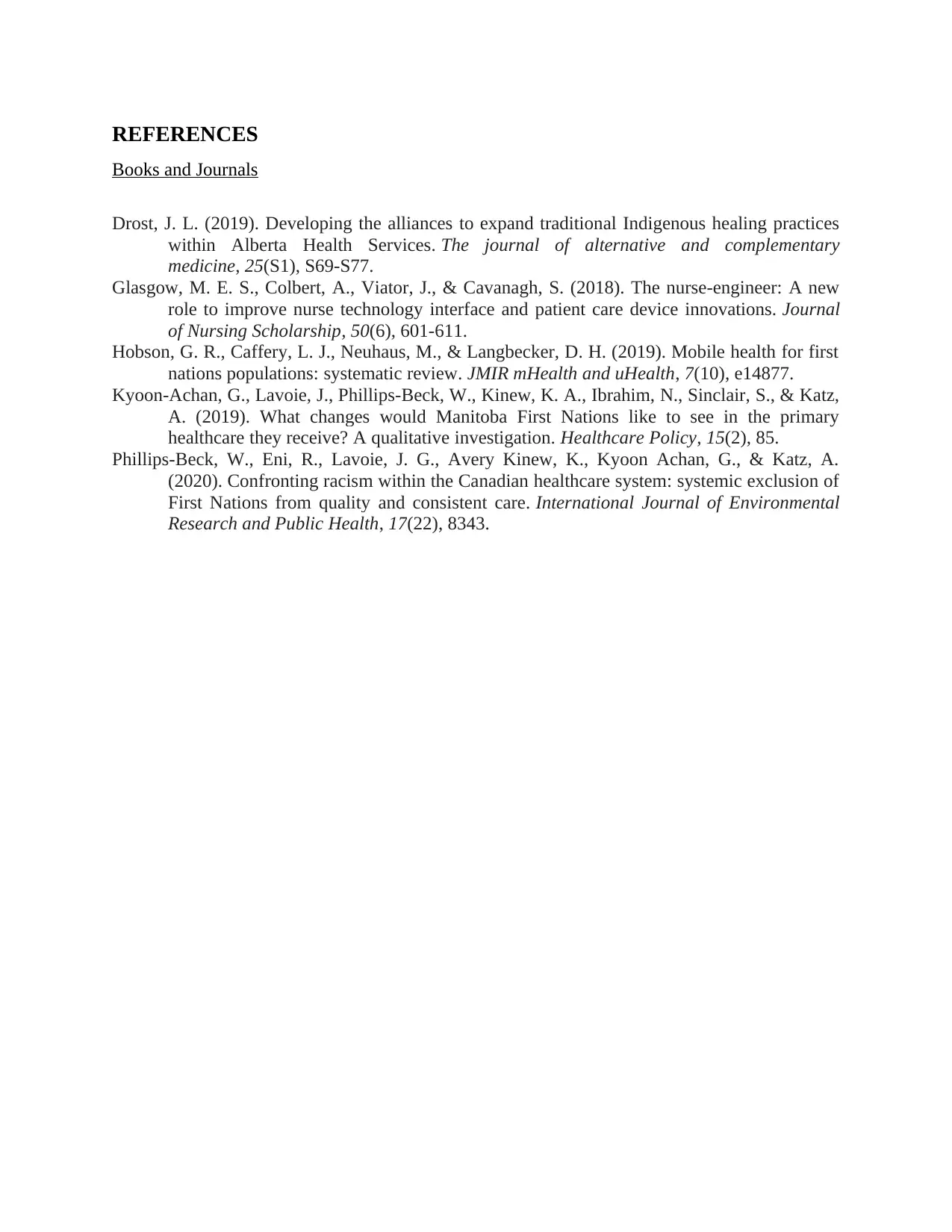
REFERENCES
Books and Journals
Drost, J. L. (2019). Developing the alliances to expand traditional Indigenous healing practices
within Alberta Health Services. The journal of alternative and complementary
medicine, 25(S1), S69-S77.
Glasgow, M. E. S., Colbert, A., Viator, J., & Cavanagh, S. (2018). The nurse‐engineer: A new
role to improve nurse technology interface and patient care device innovations. Journal
of Nursing Scholarship, 50(6), 601-611.
Hobson, G. R., Caffery, L. J., Neuhaus, M., & Langbecker, D. H. (2019). Mobile health for first
nations populations: systematic review. JMIR mHealth and uHealth, 7(10), e14877.
Kyoon-Achan, G., Lavoie, J., Phillips-Beck, W., Kinew, K. A., Ibrahim, N., Sinclair, S., & Katz,
A. (2019). What changes would Manitoba First Nations like to see in the primary
healthcare they receive? A qualitative investigation. Healthcare Policy, 15(2), 85.
Phillips-Beck, W., Eni, R., Lavoie, J. G., Avery Kinew, K., Kyoon Achan, G., & Katz, A.
(2020). Confronting racism within the Canadian healthcare system: systemic exclusion of
First Nations from quality and consistent care. International Journal of Environmental
Research and Public Health, 17(22), 8343.
Books and Journals
Drost, J. L. (2019). Developing the alliances to expand traditional Indigenous healing practices
within Alberta Health Services. The journal of alternative and complementary
medicine, 25(S1), S69-S77.
Glasgow, M. E. S., Colbert, A., Viator, J., & Cavanagh, S. (2018). The nurse‐engineer: A new
role to improve nurse technology interface and patient care device innovations. Journal
of Nursing Scholarship, 50(6), 601-611.
Hobson, G. R., Caffery, L. J., Neuhaus, M., & Langbecker, D. H. (2019). Mobile health for first
nations populations: systematic review. JMIR mHealth and uHealth, 7(10), e14877.
Kyoon-Achan, G., Lavoie, J., Phillips-Beck, W., Kinew, K. A., Ibrahim, N., Sinclair, S., & Katz,
A. (2019). What changes would Manitoba First Nations like to see in the primary
healthcare they receive? A qualitative investigation. Healthcare Policy, 15(2), 85.
Phillips-Beck, W., Eni, R., Lavoie, J. G., Avery Kinew, K., Kyoon Achan, G., & Katz, A.
(2020). Confronting racism within the Canadian healthcare system: systemic exclusion of
First Nations from quality and consistent care. International Journal of Environmental
Research and Public Health, 17(22), 8343.
1 out of 5
Related Documents
Your All-in-One AI-Powered Toolkit for Academic Success.
+13062052269
info@desklib.com
Available 24*7 on WhatsApp / Email
![[object Object]](/_next/static/media/star-bottom.7253800d.svg)
Unlock your academic potential
Copyright © 2020–2025 A2Z Services. All Rights Reserved. Developed and managed by ZUCOL.





